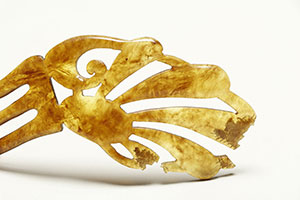Cellulose Esters (Cellulose Nitrate and Cellulose Acetate)
This research addresses the urgent need for treatments strategies for conservation of objects and works of art made from cellulose acetate (CA) and cellulose nitrate (CN).
Cellulose acetate and cellulose nitrate have been used to produce a large variety of artifacts thanks to their properties such as versatility and transparency. They are transparent like glass but with the advantage of being flexible, re-shapeable, and light. They can be molded, shaped, and carved, and made into any color or pattern. They can even have different grades of hardness depending on the plasticizers used. Their introduction not only revolutionized the commercial marketplace but also the fine art field, as they gave a new dimension to artists' techniques. They were the first plastic materials to be used by artists; among the best-known works of art made with these materials are the modernist sculptures by Constructivist artists Naum Gabo and Antoine Pevsner.
Many works made with CA and CN are considered iconic artworks and artifacts of the twentieth-century; however some of these pieces also gained notoriety as dramatic examples of the degradation of these early plastics.
Cellulose acetate and cellulose nitrate have proven to be inherently unstable due to their poorly stabilized and largely experimental formulations and have shown to be among the four plastics that deteriorate most rapidly in museum collections. One of the results of their chemical degradation is the production of acid gasses that can cause the autocatalytic breakdown of these polymers. At present the risk of losing a significant part of our cultural heritage is very high; objects from different types of collections, including art, design, fashion and historical collections, have literally disintegrated, and many others are currently in poor condition.
Since the 1990s, conservators and scientists have been pointing out the urgency of establishing treatments to conserve degraded cellulose acetate and cellulose nitrate. However, to date, there have been no viable solutions.
Recognizing this urgency, this research component focuses on investigating materials and methods to stabilize, consolidate, and protect degraded objects made with these cellulose esters plastics in order to minimize damage and extend the lifetime of these works.
The research strategy process includes:
examining and investigating CA and CN objects, from different museum collections, showing instability;
testing treatment options on test samples as well as on degraded study objects in the Plastics Reference Collection and on de-accessioned artifacts;
evaluating treatments' effectiveness and suitability via combined scientific testing and visual assessment.
To assess research goals the project team is collaborating with experts in the scientific field, museums, and the Getty Research Institute (GRI). A large collection of combs, containing CA and CN, part of the Harald Szeemann Archival Collection from the GRI currently serves as case study. A selection of these combs were featured in Szeemann's historic 1974 exhibition, Grandfather, A Pioneer Like Us, which will be re-created for a forthcoming exhibition at the Getty Research Institute on the life and work of Harald Szeemann.
Image Gallery
Page updated: June 2017



















